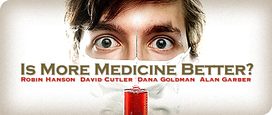Per capita income in the United States is 30 percent higher than in Sweden, and yet Americans are no happier than Swedes; indeed, Swedes report greater levels of happiness. Based on these data, can one conclude that cutting income in the United States by 30 percent across the board would leave Americans unaffected? Of course, this is folly. It cannot be the case that 30 percent of U.S. GDP is not contributing to material improvement. Rather, Sweden makes up for lower average incomes with a more equal income distribution and with the provision of more social goods. The net effect on happiness is a wash.
Let me translate the analogy to medical spending. We observe that areas that spend 30 percent more than other areas do not get better outcomes. It is possible that randomly cutting 30 percent of spending in high spending areas would not affect outcomes. But this is not likely. Cutting spending by 30 percent would almost surely eliminate some valuable services as well as some less valuable ones. One could make up for the loss of valuable services by providing other services that are low cost but not currently provided. Overall health might not be affected, but money would be saved. Better still would be to selectively eliminate the care that has little value and provide the other services that are valuable but are not currently provided. This would leave us spending less and with better health. I believe we can do this, but the task is harder than it seems at first pass. We don’t do ourselves any favors by pretending it is easy.

